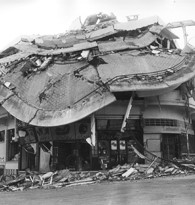On February 29, 1960, a magnitude 5.7 earthquake struck Agadir, Morocco. The 15-second event killed thousands and leveled parts of the city.
It was a clear, warm evening and many in the city were feasting in observance of the third night of Ramadan, the season in which Muslims traditionally fast during daylight. At 11:41 p.m., the ground lurched.
“The earth was kicked from under us,” a survivor said, according to a report by the U.S. Geological Survey (USGS).
Slight shocks had been felt throughout the week, with a stronger tremor at noon that same day.
Though “disquieting,” the tremors failed to raise alarms in “a region in which common knowledge insisted earthquakes ‘never’ occurred,” the USGS reported.
The town was filled with frail historic stone structures, and even the newer construction in the city lacked adequate reinforcement. The weakness of the buildings, and the unusually shallow quake activity just below the earth’s surface, made the 15-second, geologically “moderate” quake especially deadly.
“Within a period of a few seconds, the bulk of the city was completely destroyed,” the USGS said.
The first news of the disaster was reported to the outside world by the radios of Spanish fishing vessels anchored in the harbor. Rescue teams from around the world came to help the earthquake victims. Despite many international relief efforts, the destruction was so great that few survivors were found, though some were rescued from under crumbled buildings 10 days after the earthquake.
At least 12,000 people were killed and another 12,000 were injured. The 5.7 magnitude quake is considered the most destructive “moderate” earthquake of the 20th century, according to USGS.
Following the earthquake, nearly $45 million was spent to reconstruct Agadir and reduce the potential for future earthquake damage. Morocco’s King Mohammad offered part of his personal fortune to help the city start rebuilding. Today, the town is a popular tourist destination.
Photos and videos of Agadir and the resultant damage from the earthquake are available at photo-sharing web site PBase.
Morocco has seen other earthquakes. On February 24, 2004, more than 500 people were killed when a 6.5-magnitude earthquake struck in the Strait of Gibraltar off Morocco’s northern coast.
Sources in This Story
- USGS: Historic Earthquakes: Agadir, Morocco
- British Movietone (YouTube): The Tragedy of Agadir
- Time: Morocco. The Dead City
- PBase: Agadir Earthquake
- CNN: Over 500 killed in Morocco quake
- MSNBC: What causes earthquakes?
- USGS: Measuring Earthquakes
Reference: What causes earthquakes?
The pulling apart and collision of tectonic plates under the earth’s surface cause earthquakes. Learn more about plate tectonics and earthquakes from MSNBC’s interactive feature.
Earthquake vibrations are recorded by instruments called seismographs. The magnitude of an earthquake is measured on the Richter Scale. The smallest earthquake people can generally feel is a magnitude two. Earthquakes measuring a magnitude six or more are usually considered major earthquakes.
The Pacific Disaster Center has recorded a history of earthquakes around the world that caused significant damage.
FindingDulcinea has created a Morocco Travel Web Guide that allows users to take a virtual tour of the country and a plan a visit there.
One of the more perilous and baffling natural phenomena in the world is the earthquake, which is the subject of a Netcetera feature.











